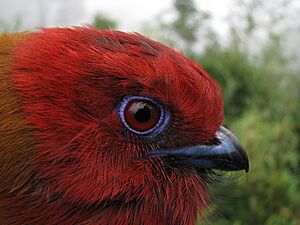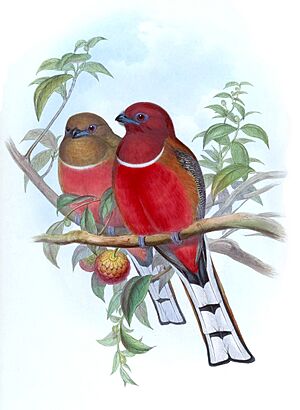Red-headed trogon facts for kids
Quick facts for kids Red-headed trogon |
|
|---|---|
 |
|
 |
|
| Conservation status | |
| Scientific classification | |
| Genus: |
Harpactes
|
| Species: |
erythrocephalus
|
The red-headed trogon (Harpactes erythrocephalus) is a beautiful bird that belongs to the Trogonidae family. It's known for its bright colors, especially the male's striking red head.
Contents
What's in a Name?
The name Harpactes erythrocephalus comes from ancient Greek words. Erythros means "red," and kephale means "head." So, its scientific name literally means "red-headed"!
What Does It Look Like?
The Red-headed Trogon is usually about 34 centimeters (about 13 inches) long.
Male Trogons
Male Red-headed Trogons are easy to spot! They have a bright, dull crimson (dark red) head, neck, and upper chest. This red color is quite special among trogons.
Below their red chest, there's a thin white band. Their lower chest and belly are light red to pink. Their back and shoulders are a rusty brown. Their legs are a cool mauve-blue color.
Their wings have a mix of black and white patterns. Their long tail feathers are dark brown with black tips in the middle, and the outer feathers are white with black bases. For their face, they have a cobalt blue bill with a black tip, a deep mauve-blue area around their mouth, and reddish-brown eyes.
Female Trogons
Female Red-headed Trogons look a bit different. Their head, neck, and upper chest are olive-brown. Like the males, they also have a thin white band across their chest, and their lower chest and belly are light red to pink.
Their back is orange to brown. Their wings are patterned with dark brown and yellowish-brown. Their tail feathers are very similar to the males'. Females have a paler blue bill and a light blue area around their eyes.
Young Trogons
Young Red-headed Trogons have buff brown heads and upper parts. Their undersides are buff white. Their central tail feathers are narrower and don't have a black tip.
Size and Weight
Here are some average measurements for these birds:
| Male | Female | |
|---|---|---|
| Weight (grams) | 85-110 | 76 |
| Wing length (millimeters) | 144-156 | 140-156 |
| Tail length (millimeters) | 154-185 | 160-192 |
| Bill length (millimeters) | 19-21 | 19-21 |
| Leg length (millimeters) | 16-18 | 16-18 |
Where Do They Live?
The Red-headed Trogon lives in many parts of Asia. You can find them from central Nepal across Southeast Asia, southern China, and even on the island of Sumatra.
They prefer to live in forests that are high up in the mountains, especially dense broadleaved forests. In the Himalayan foothills, they live in tropical and subtropical areas. In Southeast Asia, they like evergreen forests at heights from 300 to 2600 meters (about 980 to 8,500 feet).
In Myanmar, they live in bamboo and oak forests around 2500 meters (about 8,200 feet) high. They are also found in evergreen forests in Laos and Vietnam. In Thailand, they prefer older evergreen forests between 400 and 2000 meters (about 1,300 to 6,500 feet). On the Malay Peninsula, they live in evergreen forests from 300 to 1680 meters (about 980 to 5,500 feet) high.
How Do They Behave?
Red-headed Trogons are often seen sitting quietly on shaded branches, either alone or in pairs, waiting for their next meal. When they fly between trees, they often fly slowly and very low to the ground, just a few meters up.
They are most active in the early morning and at night. At night, they sometimes chase moths at the edges of forest clearings.
In some areas, like central southern Thailand, they share their home with the Orange-breasted Trogon. These two species sometimes follow groups of other birds that are looking for food. This way, they can catch insects that the other birds scare out.
Most Red-headed Trogons stay in one area. However, some have been seen moving between different mountain heights in northern and southern Laos.
Their Calls
The male Red-headed Trogon has a special call. It sounds a bit like the Eurasian golden oriole. It's a series of usually five or six soft "tyaup" notes, spaced out, and repeated about once a minute. Sometimes, the male makes a longer "pluu-du" sound that drops in pitch at the end. This call is repeated every 3 to 6 seconds.
What Do They Eat?
Red-headed Trogons mainly eat insects and their young. This includes green grasshoppers, stick-insects, cicadas, millipedes, flies, beetles, centipedes, woodlice, and moths. They also eat some leaves and fruits.
Reproduction and Life Cycle
Red-headed Trogons usually build their nests in natural holes in trees. These holes are typically 1.5 to 5 meters (about 5 to 16 feet) above the ground. The entrance hole is usually wide. Sometimes, the male and female will dig out the entire nesting hole themselves! They might also use old nesting holes made by woodpeckers or barbets.
The female usually lays 2 to 4 round, cream-colored, shiny eggs. Each egg is about 26.5-27.5 mm long and 23.5-24.0 mm wide.
Both the male and female help with nesting. They both dig the nest, sit on the eggs to keep them warm (this is called incubating), and feed their young. The female spends more time incubating the eggs and keeping the chicks warm, especially at night. The male brings food for the chicks. During the day, the parents take turns warming the eggs or chicks, and sometimes they even do it together.
In Thailand, nesting happens from March to July. The chicks hatch after about 18 days. They leave the nest about 13 or 14 days after hatching. In Northern India, females lay eggs between mid-April and mid-July, with most eggs laid in May and June. In China and Myanmar, they lay eggs in April.






